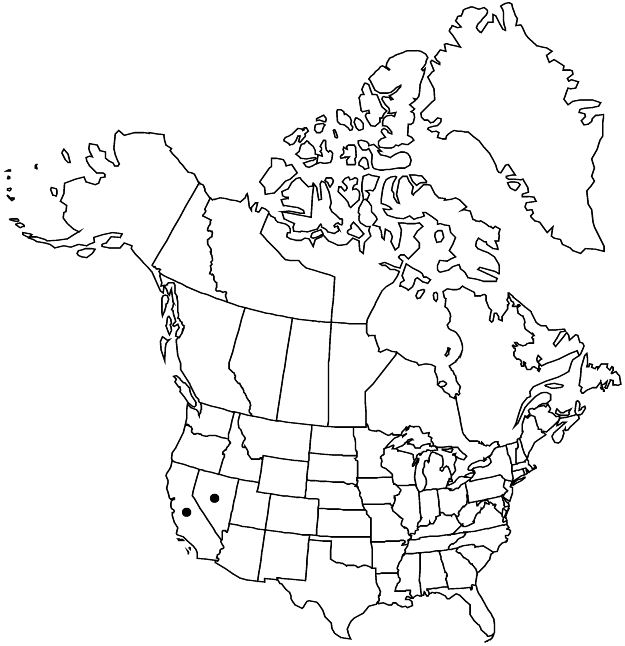Difference between revisions of "Euphorbia parishii"
Bull. Calif. Acad. Sci. 2: 56. 1886.
FNA>Volume Importer |
FNA>Volume Importer |
||
| Line 16: | Line 16: | ||
|name=Chamaesyce parishii | |name=Chamaesyce parishii | ||
|authority=(Greene) Millspaugh | |authority=(Greene) Millspaugh | ||
| − | }}{{Treatment/ID/Synonym | + | }} {{Treatment/ID/Synonym |
|name=Euphorbia polycarpa var. parishii | |name=Euphorbia polycarpa var. parishii | ||
|authority=(Greene) Jepson | |authority=(Greene) Jepson | ||
| Line 34: | Line 34: | ||
|elevation=-90–600 m. | |elevation=-90–600 m. | ||
|distribution=Calif.;Nev. | |distribution=Calif.;Nev. | ||
| − | |discussion=<p>Euphorbia parishii is common in the Death Valley region of southern California, where it is often encountered well below sea level. The species is frequently confused with E. micromera and E. polycarpa but differs from the former in being a more robust plant with larger cyathia and from the latter in lacking involucral gland appendages.</p> | + | |discussion=<p><i>Euphorbia parishii</i> is common in the Death Valley region of southern California, where it is often encountered well below sea level. The species is frequently confused with <i>E. micromera</i> and <i>E. polycarpa</i> but differs from the former in being a more robust plant with larger cyathia and from the latter in lacking involucral gland appendages.</p> |
|tables= | |tables= | ||
|references= | |references= | ||
| Line 58: | Line 58: | ||
|publication year=1886 | |publication year=1886 | ||
|special status=Endemic | |special status=Endemic | ||
| − | |source xml=https://jpend@bitbucket.org/aafc-mbb/fna-data-curation.git/src/ | + | |source xml=https://jpend@bitbucket.org/aafc-mbb/fna-data-curation.git/src/8f726806613d60c220dc4493de13607dd3150896/coarse_grained_fna_xml/V12/V12_913.xml |
|genus=Euphorbia | |genus=Euphorbia | ||
|section=Euphorbia sect. Anisophyllum | |section=Euphorbia sect. Anisophyllum | ||
Revision as of 15:50, 18 September 2019
Herbs or subshrubs, perennial, with thickened and often woody rootstock. Stems prostrate, sometimes forming dense mounds, 10–50 cm, glabrous. Leaves opposite; stipules distinct, subulate-filiform, 0.3–0.9 mm, pilose; petiole 0.3–1.2 mm, glabrous; blade usually ovate, rarely oblong, 2–7 × 1–5 mm, base usually asymmetric, rounded to hemicordate, margins entire, apex usually obtuse, rarely acute, surfaces glabrous; only midvein conspicuous. Cyathia solitary at distal nodes; peduncle 0.1–0.6(–2.2) mm. Involucre obconic to campanulate, 1–1.4 × 0.9–1.3 mm, glabrous except for pilose lobes; glands 4, pink to maroon, circular, 0.3–0.4 × 0.3–0.4 mm; appendages absent. Staminate flowers 40–50. Pistillate flowers: ovary glabrous; styles 0.3–0.6 mm, 2-fid 1/2 length. Capsules ovoid to oblate-ovoid, 1.6–1.7 × 1.6–1.9 mm, glabrous; columella 1.2–1.5 mm. Seeds whitish to light brown, ovoid, 4-angled in cross section, 1.2–1.4 × 0.6–0.8 mm, rugose or with indistinct, irregular, low transverse ridges.
Phenology: Flowering and fruiting fall–summer.
Habitat: Desert scrub, often with creosote bush, disturbed roadsides, rocky soils.
Elevation: -90–600 m.
Discussion
Euphorbia parishii is common in the Death Valley region of southern California, where it is often encountered well below sea level. The species is frequently confused with E. micromera and E. polycarpa but differs from the former in being a more robust plant with larger cyathia and from the latter in lacking involucral gland appendages.
Selected References
None.
